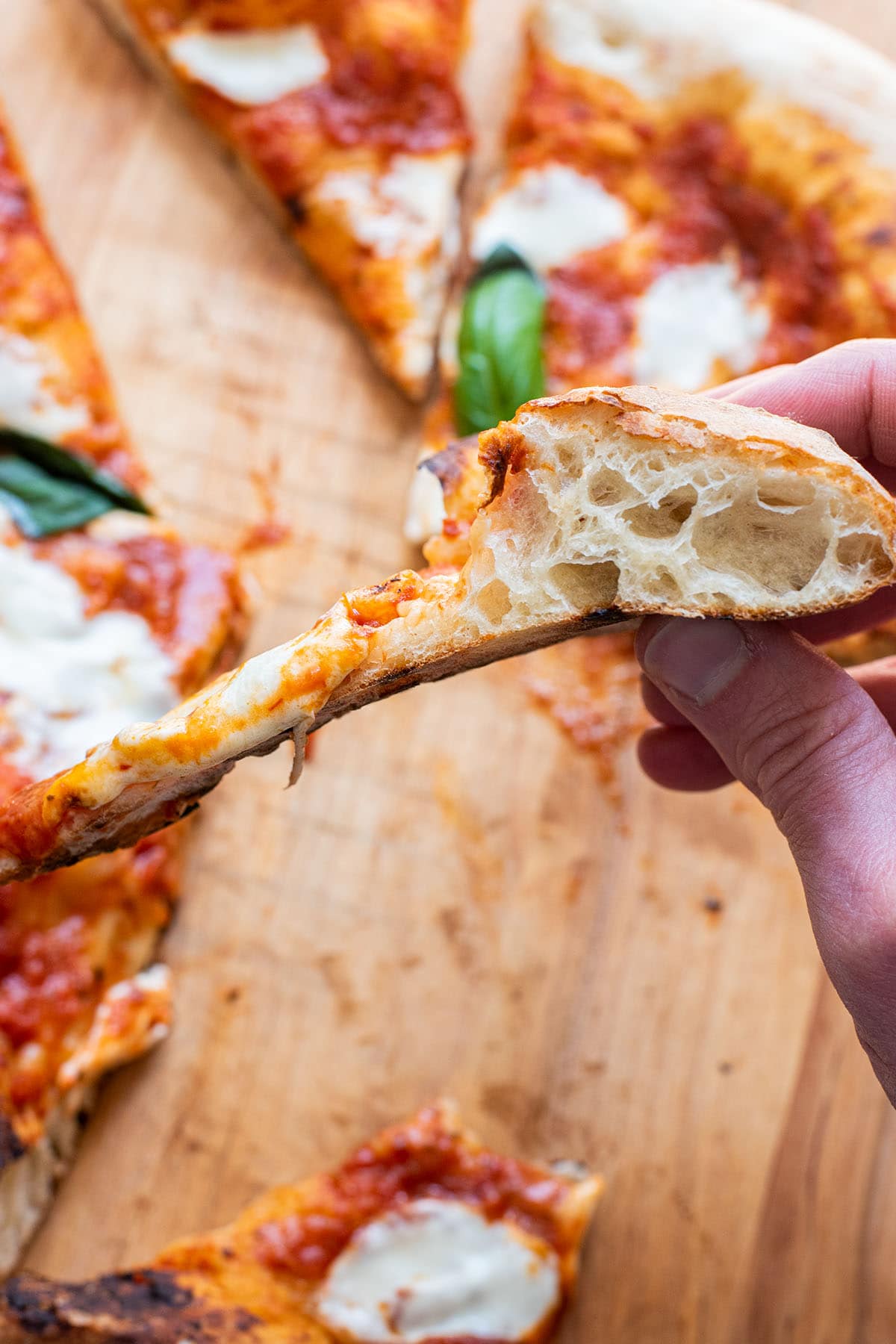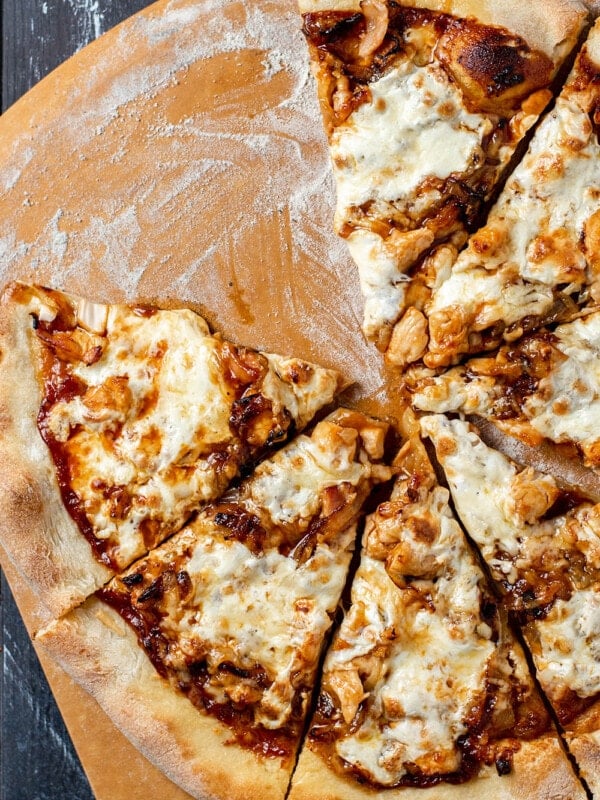This post may contain affiliate links. Please read our disclosure policy.
Margherita pizza or ‘pizza Margherita’ is the simplest, yet most difficult pizza to absolutely nail. with such simple ingredients, there is nowhere to hide mistakes. This recipe is fairly true to ‘authentic’ Italian pizza. Let’s learn how to make the best homemade pizza you’ve ever made!

Margherita pizza is made with a simple tomato sauce, buffalo mozzarella, a drizzle of olive oil, and fresh basil leaves. The simplicity and freshness of the ingredients are what makes this pizza so phenomenal. Outside of the authentic fresh Italian ingredients, Neapolitan-style pizza is the technique of quickly cooking pizza at very high temperatures.
I’ve been painstakingly trying to perfect Neapolitan-style pizza using a conventional kitchen oven. It’s impossibly hard to match the qualities of a 1000-degree brick oven using a regular oven, however, I’ve gotten close with the right tools and techniques.
After much trial and error, I’ve finally cracked the code for making really good homemade pizza without expensive equipment.
If you enjoyed this recipe, try my skillet pizza recipe and also learn how to grill pizza!
Table of Contents
Why This Recipe Works
This recipe is based on creating the hottest environment in your oven as possible. I use a few important techniques to augment my oven’s cooking power!
- A hot oven and preheated baking steel will help to cook the pizza very quickly, rendering a light and airy crust with irresistible charring.
- Broiling the pizza halfway through will sear the crust and provide a perfect golden finish with beautiful charring on the top and crust.
Equipment
- Pizza baking steel: steel has a much greater heat potential and does a better job at transferring heat than a baking sheet or pizza stone. I love mine.
- Pizza peel: this is essential for sliding your pizza on and off your pizza steel.
Ingredient Notes and Substitutions

- Pizza dough: make your own or use store-bought. Regardless, make sure the dough has had 3-4 hours to proof/warm on the counter before baking.
- Fresh buffalo mozzarella: most Margherita pizza in Italy is made with buffalo mozzarella since it’s rich and creamy. If you can’t find that, regular fresh mozzarella works too.
- Freshly grated parmigiano-reggiano: this is optional but adds a pop of delicious salty flavor.
- Extra virgin olive oil: I lightly drizzle my pizza with nice olive oil just before serving. It adds awesome flavor.
- Canned San Marzano tomatoes: always look for Peeled San Marzano tomatoes imported from Italy. These are grown near Mount Vesuvius. I make homemade tomato sauce with the same tomatoes.
- Semolina or all-purpose flour: a well-floured pizza peel helps make sliding your pizza into your oven a breeze. Semolina flour is more coarse and acts like ball bearings. Regular flour works fine too.
- Garlic: garlic is an optional ingredient for the pizza sauce. Neapolitan pizza sauce usually omits garlic as it can be overpowering.
- Pizza sauce: if you aren’t up for making your own pizza sauce, I really like Pastene brand California Pizza Sauce.
See the recipe card for full information on ingredients and quantities below.

How to Make Neapolitan-Style Pizza
Step 1.
For the homemade sauce: Combine tomatoes, oil, and salt in a small bowl. Blend with an immersion blender until smooth. You can also pulse a blender or food processor. Add more salt to taste as needed. This will render more sauce than you need. I use 1/3-1/2 cup of sauce for each pizza. For a more rustic sauce, you can hand-crush the tomatoes or use a potato masher. If the sauce is too acidic, add a TINY pinch of sugar.


Step 2.
For the pizza: Remove the dough from the fridge before cooking to proof. Place dough in a greased bowl and seal with plastic wrap or aluminum foil. Let rest on the counter for 3-4 hours or until the dough is no longer cool to the touch. This is very important for soft and airy crust. The dough will puff up and nearly double in size.


Step 3.
Preheat the oven to as hot as it can go, usually 500-550°F. Place the pizza steel (or pizza stone) in the oven and let preheat for one hour. I position my rack about 8 inches from the top burner.
Step 4.
Place the dough onto a floured surface and shape/stretch it into a 12-inch crust with your hands. Be sure the dough is adequately floured and not sticky. Try to get the crust as thin as possible in the center, about 1/4 inch thick. This is best done with your hands by gently stretching. Avoid a roller for best results.

Step 5.
Place a small handful of flour onto a pizza peel and spread evenly to prevent the dough from sticking to the peel.
Step 6.
Transfer the dough onto the peel. Evenly coat with sauce leaving a 1-inch crust all the way around. Add the fresh mozzarella strips or cubes. Do not overcrowd.


Step 7.
Slide the finished pizza onto the steel and bake for 5-6 minutes or until the pizza is 80% done. Turn on the oven’s broiler and broil on high for 2-3 additional minutes or until the crust is just starting to char on top.
Step 8.
Remove from the oven and immediately top with freshly and finely grated parmigiano reggiano. Serve topped with fresh basil leaves and a circular drizzle of extra virgin olive oil.

Room Temperature Ingredients
Using room-temperature toppings (cheese and sauce) and pizza dough is arguably the most important step for a number of reasons. Room temperature dough is much more malleable and less elastic. You will have a much easier time shaping the crust without the need to use a rolling pin, which forces out the desired air bubbles.
Overworking cold dough will stiffen the gluten and will result in pizza that is bread-like, dense, and tough. Room temperature dough will cook much faster and puff up around the edges when cooked, rendering a perfect light and airy crust with amazing texture and crunch.
Always let the dough rest on the counter for 3-4 hours so it can warm up prior to starting. This will relax the gluten, allowing the dough to maintain its desired shape without snapping back. If you’re making your own pizza dough, here is a great 72-hour pizza dough recipe.
Neapolitan Pizza Sauce
The best homemade pizza is made with authentic pizza sauce. I’ve hacked together my own Italian-inspired sauce using canned San Marzano tomatoes, olive oil, and a pinch of salt. The sauce is very simple but tastes fresh and authentic. Plus it only takes a minute to spin together. Take a look at Marcella Hazan’s tomato sauce next!
All you need to do to make this sauce is blend a few whole canned tomatoes with salt and olive oil. You can use an immersion blender or even a single-serve blender to gently blend the tomatoes into a smoother texture.
For the best tomatoes, look for imported San Marzano Peeled Tomatoes. These are grown in the Sarnese-Nocerino district and are renowned for their quality due to the mineral-rich volcanic soil near Mount Vesuvius. Pastene and Cento are two brands I’ve used.
Several homemade pizza sauce recipes call for precooking the sauce before topping the pizza. The high oven temps will cook the tomatoes adequately so there is no need to do so. By heating the sauce only once, you’ll also preserve the tomato’s freshness. You will be amazed at the difference in the quality of homemade pizza sauce over jarred.

Expert Tips
- Always go light on the sauce and cheese. It’s very tempting to load up on both however authentic Italian pizza is mainly focused on the dough.
- Light toppings keep the crust from getting saturated and soggy. Fresh mozzarella contains more moisture than processed shredded cheese, so by keeping toppings light, you will help your crust stay crispy.
- Prepare cheese by cutting it into small cubes or thin strips. You should be able to see the sauce around the finished melted cheese. Strips are by far my favorite method for better melting.
Frequently Asked Questions
A pizza steel has made the BIGGEST difference in my homemade pizza. Use a pizza stone at a bare minimum.
Margherita pizza is cheese pizza made with mozzarella cheese, red sauce, fresh basil, and olive oil.
Authentic Margherita pizza does not contain freshly sliced tomato as a topping. The sauce is made from San Marzano tomatoes.
I always recommend fresh mozzarella. An alternative would be whole milk-low moisture mozzarella that is cut into strips or cubed. Don’t use pre-shredded cheese for best results.
More Pizza Recipes
Enjoy this recipe? If you made this recipe, please leave a ★ ★ ★ ★ ★ star rating in the recipe card below & a review in the comments!
Margherita Pizza Recipe

Ingredients
- 16-18 ounces pizza dough, room temp
- 1/3-1/2 cup pizza sauce
- 4 ounces fresh buffalo mozzarella, cut into small cubes or thin strips
- Freshly grated parmigiano-reggiano, optional
- 3-4 fresh basil leaves, for topping
- Extra virgin olive oil, for drizzling
Homemade pizza sauce (makes 1 cup)
- 3 canned San Marzano tomatoes + 2 tablespoons of sauce from the can, look for certified Cento San Marzano Peeled Tomatoes
- 2 teaspoons olive oil
- pinch of salt, to taste
- 1 garlic clove, optional
Instructions
For the homemade sauce
- Combine tomatoes, oil, and salt in a small bowl. Blend with an immersion blender until smooth. You can also pulse a blender or food processor. Add more salt to taste as needed. This will render more sauce than you need. I use 1/3-1/2 cup of sauce for each pizza. For a more rustic sauce, you can hand-crush the tomatoes or use a potato masher. If the sauce is too acidic, add a TINY pinch of sugar.
For the pizza
- For the pizza: Remove the dough from the fridge before cooking to proof. Place dough in a greased bowl and seal with plastic wrap or aluminum foil. Let rest on the counter for 3-4 hours or until the dough is no longer cool to the touch. This is very important for soft and airy crust. The dough will puff up and nearly double in size.
- Preheat the oven to as hot as it goes, usually 500-550°F. Place the pizza steel (or pizza stone) in the oven and let preheat for one hour. I position my rack about 8 inches from the top burner.
- Place the dough onto a floured surface and shape/stretch it into a 12-inch crust with your hands. Be sure the dough is adequately floured and not sticky. Try to get the crust as thin as possible in the center, about 1/4 inch thick. The parimeter crust can be thicker. This is best done with your hands by gently stretching. Avoid a roller for best results.
- Place a small handful of flour onto a pizza peel and spread evenly to prevent the dough from sticking to the peel.
- Transfer the dough onto the peel. Evenly coat with sauce leaving a 1-inch crust all the way around. Add the fresh mozzarella strips or cubes. Do not overcrowd.
- Slide the finished pizza onto the steel and bake for 5-6 minutes or until the pizza is 80% done. Turn on the oven broiler and broil on high for 2-3 additional minutes or until the crust is just starting to char on top.
- Remove from the oven and immediately top with freshly and finely grated parmigiano reggiano. Serve topped with fresh basil leaves and a circular drizzle of extra virgin olive oil.
Notes
Nutrition
Nutrition information is automatically calculated, so should only be used as an approximation.


















I love this pizza, it’s my favorite! Great directions.
Love! Can the leftover sauce be saved? We made extra .. but wondering how/for how long?
Hey Ashley – You can absolutely freeze it for use later. Not sure how long it will last but probably 4-6 months.